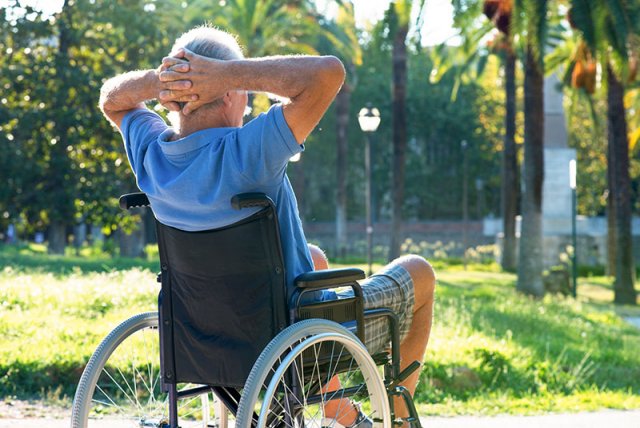Spinal paralysis (paraplegia/tetraplegia)
Bladder paralysis in cases of spinal cord injury

The spinal cord inside the spine is a kind of wire connecting the brain’s control centres to the arms, legs and internal organs. Hundreds of thousands of nerve pathways pass through the spinal cord, carrying information from the brain to the body and vice versa. An injury to any part of the spinal cord also affects nerve pathways, interfering with the flow of information in both directions. This is known as spinal paralysis, which can be complete (all the nerve pathways in the spinal cord are severed) or incomplete (some of the nerve pathways remain intact).
Spinal paralysis can be congenital or acquired. Congenital spinal paralysis is usually due to malformation of the spine and spinal meninges, known as spina bifida. In this condition, the spinal channel in the lumbar and sacral area is not completely closed, and nerve pathways are damaged. Cases of acquired spinal paralysis are divided into traumatic (following accidents or spinal surgery) and non-traumatic (stroke or inflammation of the spinal cord, disc prolapse).
There are estimated to be 3,000-4,000 patients with spinal paralysis in Switzerland, with 100-150 new cases appearing each year. Most of these individuals have bladder and sphincter paralysis, and so suffer from urinary incontinence. In many cases, modern treatment methods are successful in controlling incontinence, preventing complications and delayed after-effects, and so improving the individuals’ quality of life.
Bladder malfunction is very likely in all cases of spinal paralysis, and manifests itself through many symptoms: diminished sensation or lack of sensation of bladder filling, inability to void the bladder completely or at all, urinary incontinence. The acute phase is regarded as the period until the type of bladder paralysis can be identified and a medium-term treatment plan can be devised. In this phase of “spinal shock” the bladder is able to store urine but cannot expel it. If immediate urological action is not taken, this will lead to overflow incontinence with over-stretching of the bladder and infection of the urinary tract. Kidney malfunction may occur. The focus of neurourological treatment in the early phase of spinal paralysis is on avoiding early complications such as over-stretching of the bladder, urinary tract infection, stone formation and urethral damage. Avoiding these complications is the foundation for successful bladder rehabilitation.
Bladder rehabilitation in cases of spinal paralysis serves to classify the bladder paralysis, record risk factors and devise an individual approach to storage and voiding. This involves neurourological investigation with videourodynamic measurement, usually carried out at the end of the acute phase. A choice among the various treatment options is made in the light of the options and interests of the patient and his/her family and friends. Neurogenic bladder malfunction is not a static event: it has its own dynamics which can lead to changes in the lower and upper urinary tract. This is why patients with spinal paralysis require lifelong treatment by a specialist neurourologist. The purpose of long-term neurourological care is to provide risk-focused and patient-focused lifelong regular support to enable the patient to retain or regain his/her quality of life and life expectancy. Activities of daily living should be affected as little as possible by the consequences of bladder paralysis. A balanced bladder function and the retention or restoration of continence make a decisive contribution to improving life expectancy and quality of life for individuals with spinal paralysis.
